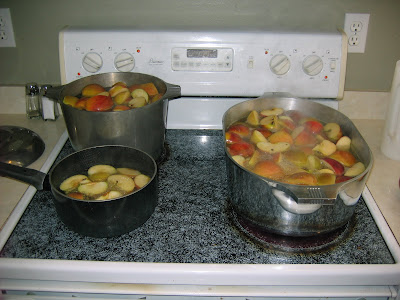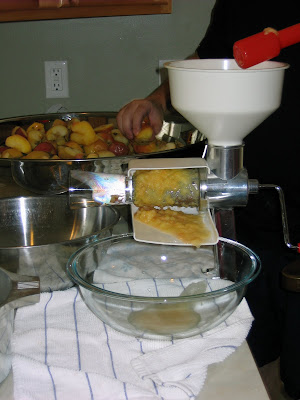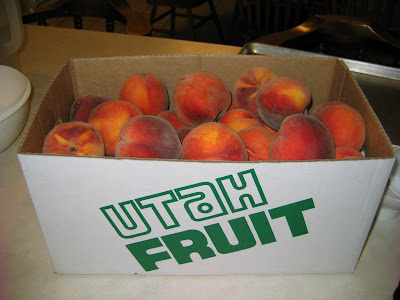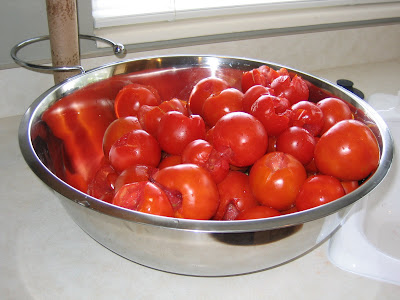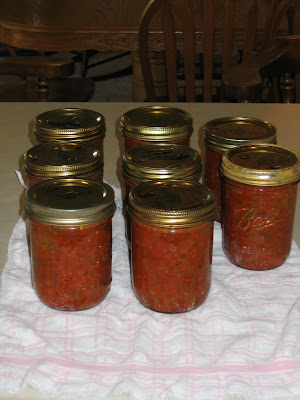Welcome to Jam Making 101, with an emphasis on the cooked method (with photos). I'll explain step by step instructions as well as go over some basics of water bath canning.
When making jam, you'll have to decide if you want to make freezer jam or cooked jam.
Difference between freezer jam and cooked jam: The basic difference is that cooked method requires that you water bath the filled canning cars so that they'll seal properly and so that they can be stored on a shelf at room temperature for long periods of time. The freezer jam method does not include water bathing, which means that the jam-filled jars must be stored in the freezer and cannot be stored at room temperature. I personally think there are some taste and texture differences between the two methods. Try both to see what you like.
Advantages/Disadvantages of freezer jam: The preparation goes a lot faster because you don't have to process the filled jars in a water bath canner. I think freezer jam is a little runnier than cooked. Also, you need to think about the space in your freezer to see if you want to have jars in there.
Advantages/Disadvantages of the cooked method: Preparation takes a lot longer because of the water bathing. Jars can be stored for several years. I think the jam is a thicker set than freezer jam.
Pectin:
Whether you choose the freezer jam method or the cooked method, you'll need to use pectin. Pectin helps the jam form. You'll use one box of pectin for each recipe you want to make, so if you want to make two recipes, buy two boxes. Inside of each box of pectin is a list of recipes for both freezer jam and cooked jams. There are recipes for various berries and fruits. The recipes will tell you how much fruit to buy and what other ingredients you will need. Lemon juice and sugar are two common ingredients.
Pectin can be bought in boxes at grocery stores or at Walmart, although it can be hard to find during canning season. Pay attention to the type you are buying. Some is used for sugarless or reduced sugar recipes and some is not.**TIP** Buy a few boxes ahead of time and stash them away so you don't have to hunt for it. I've seen Walmart carry it year round.
Fruit:
Pay attention to the guidelines for fruit buying and preparation given in the recipe. Usually overly ripe fruit is not a good choice for jam because it can affect the way the jam sets up. Pick ripe, firm fruit and prepare it according to directions. Here I have washed and stemmed my strawberries.

Since the recipe indicated that the strawberries be mashed (not pureed), I saved myself some time and let my machine slice them up.

I don't have a potato masher, but if I did, I would have used it. To accomplish the mashing, I used a large cup and smashed them well.
Measuring:
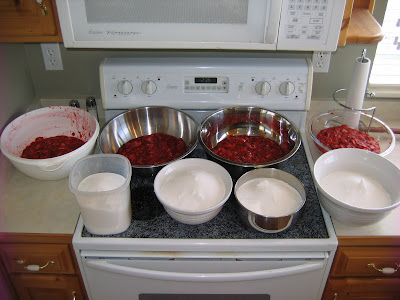
I wanted to make 4 batches. I measured everything exactly according to the directions. Since proper jam formation depends on the ratio of fruit, sugar, and pectin, you don't want to mess around with the recipe. Prepare and measure the ingredients as instructed, otherwise your jam may not turn out. Also, keep each recipe separate if you are doing muliple batches. You don't want to mix it all together because you want each batch to retain a proper acidity level (from the lemon juice).
Making the process easier: Making jam is messy. So sticky. It seems I am always reaching for another spoon, or plate, or washcloth. One trick I've learned is to rinse along the way. Instead of throwing the sticky items into the sink to be dealt with later, rinse them quickly with hot water. This will especially help if you are doing multiple batches one right after another.
Another tip is to do as much prep as you can before you start the cooking process. Slice, mash, stir, measure, etc. before you turn the stove on. And, make sure all bottles are washed and ready, and that rings and lids are handy. Once you start cooking, the pace quickens and it's much easier if you have everything lined up in an orderly way.
Keep several hotpads handy. They can get sticky and wet, so you'll probably go through several of them.
Reread the directions before beginning so that you are very clear about what to do. This will save you a ton of trouble.
Cook according to instructions:
Cook the jam according to the instructions. This recipe called for 4 minutes of a rolling boil with constant stirring. It is common to see foam form on the top. Be sure to use a large pot and expect that the foam will rise up. If you are using an electric stovetop, be cautious about setting the temperature all the way up to High. If the heat is too great and it boils up too quickly, you won't be able to adjust the temperature down as quickly as you need to and you'll risk a boil-over. It's better to start with med-high and slowly work up in temperature on an electric stovetop.
Live and Learn: 
I thought I'd brilliantly manage two pots at once, which was a dumb idea in and of itself. To complicate matters, this pot was not big enough AND I had the temp too high. The result: a boil-over and a big mess. I've decided that managing one very large pot at a time on a slighly lower temperature is the way to go. After salvaging most of this recipe, switching to a bigger pot, and cleaning up the stovetop, I was back in business.
Skimming: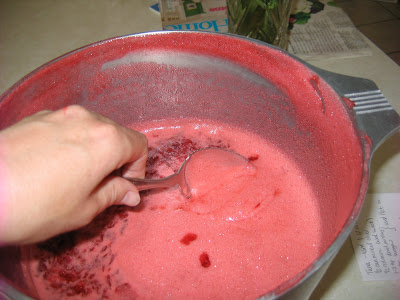
The recipe might call for skimming the foam. Once the jam is fully cooked and removed from the heat, the foam will rise to the top. If you let it sit for a minute or two, you can easily skim it off with a spoon. If you want, you can keep the foam in the fridge and use it just like jam. It will even set up a little. Underneath the foam is the dark red liquid jam. I think skimming is just a way to keep the appearance of the bottled jam dark red, pretty, and uniform.
Filling Jars: 
First of all, make sure your jars are appropriate for use. Ball, Mason, and Kerr jars are the standard brands of canning jars. Do not use old mayo jars or other commercially used jars. They are not intended for reuse. Do not use cracked jars.
Most likely you'll put your jam into one of three sizes of canning jars: pint, half pint, or jelly jar size. I've never seen anyone bottle jam into quarts. Just keep in mind, the smaller the jar, the more jars you'll have to use, thus more batches of water bathing. I like pint size best. Wide mouth is easiest to fill, but regular mouth is manageable as long as you have a funnel.
The jam will be very hot so be careful. I always put a plate underneath to catch drips and use a funnel to make filling easier.

Carefully wipe the jar with a clean, wet cloth. You don't want anything to prevent the lid from properly sealing onto the jar during processing. So, a clean lip is important.
Lids and Rings: 
Because the jars are now filled with hot jam, the glass will heat up. Therefore, the jar is at risk of breaking if cold rings or lids touch it. Most likely the recipe you use will ask you to warm up the lids and rings. Don't overly tighten the ring. It needs to be finger tight but not cranked on there. **TIP** If you buy a set of canning jars, lids and rings will come with the set. But, if you need replacement rings and/or lids, buy them early. They can be hard to find at times. Walmart is known to carry them year round and I buy them off season and stash them away.
Water Bathing: Supplies:
Supplies: You'll need three things to water bath: 1) A water bath canner with a lid, 2) an internal rack that holds seven jars, and 3) canning tongs (not shown) so you can remove hot jars. Usually a canner is sold with the rack inside, but most likely you'll have to buy the tongs separately.
Gas or electric: The advantage of a gas stovetop is that you can control the heat so much better. You can water bath on an electric stovetop, but temp control is more difficult. I've heard that you should not water bath on those flat electric stovetops because you run the risk of shattering the glass surface. Other options include a large gas camp stove like a CampChef, or side burner on an outdoor gas grill (that's what I used and it worked great). If you use a camp stove or gas grill burner, make sure the water bath canner fits nicely on over the element and is stable.
How to: Most likely the recipe you choose will include the following water bathing principles. First, you want the water to be warm before you put the filled jars in. Remember that the jars are still hot with hot jam, so you don't want them to break by putting them into a pot of cold water. Second, you want to make sure that all the jars are covered by 1-2 inches of water. They need to be completely submerged. Next, processing time does not start until the canner reaches a rolling boil (big bubbly boil). I took the photo without a lid so you could see, but I always process with the lid.
Altitude adjustment: Most likely your recipe is going to ask you increase the processing time to account for elevation. The instructions will tell you how many additional minutes you need to add to the processing time, based on your elevation.
Caution: When processing is finished, turn off the heat and let the boiling subside. You don't want to try to remove the jars while it is still boiling. Also, be very careful as the jars will be extremely hot. Keep the hot jars away from cold things, even drafts, so that they won't crack.
Next batch? If you are going to process a second batch right after the first comes out of the canner, check the water level because some of the water may have boiled out. Add hot water if needed. Even with additional water being added for the second go-around, the water bath canner will come to a rolling boil much more quickly than it did the first time.
Letting them set and seal:
Once the jars have been removed from the canner, they need to sit for while so the jam can set up and so that the jars can seal. You'll hear popping sounds as the lids seal to the jars. Do not take the rings off at this point. Doing so may loosen the newly sealed lid. Also, the jars will be very dirty from having been in the water. Do not try to clean them off while they are hot. I usually let them sit over night and then remove the rings and wipe them down.
After the jars have completely cooled, I check each lid for a proper seal by pushing down on the center of the lid. If I hear a clicking sound when I press down on the lid, that means that the lid failed to seal. In that case, I could choose to do one of two things: either open the jar for immediate use or place it as is in the freezer until I am ready to use it. An improperly sealed jar should not be stored at room temperature because its contents will spoil.
After the jars have cooled, rings have been removed, and the seals have been checked, they are ready to be dated and stored. Once a jar is opened for use, it ought to be kept in the refrigerator.
You may notice that the fruit will have floated to the top of the jar. I have not yet found a solution to this other than to give it a good mix when I open a jar to use it. If you know a trick, leave me a comment!

